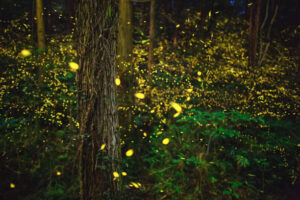how do fireflies produce light
introduction
how do fireflies produce light ? Fireflies, also known as lightning bugs, are not just charming insects that light up the night; they are nature’s own little lanterns, producing a mesmerizing glow through a fascinating process called firefly bioluminescence. In this article, we’ll delve into the captivating world of fireflies and will explore how do fireflies produce light and will discuss mechanisms firefly bioluminescence.
how do fireflies produce light: Nature’s Light Show
What is Bioluminescence?
Bioluminescence is a captivating phenomenon where living organisms produce light through a chemical reaction. It’s a widespread occurrence in the ocean depths, but fireflies bring this enchantment to terrestrial landscapes. The ability to emit light sets fireflies apart in the insect kingdom, turning their nightly activities into a magical display.

The Firefly’s Light Show
The Chemistry Behind the Glow
The magic begins with a molecule called luciferin. Fireflies possess a specialized light-emitting organ that contains luciferase, an enzyme that facilitates the oxidation of luciferin. This process results in the emission of light without generating heat—a phenomenon known as “cold light.”
The Role of Oxygen
In the presence of oxygen, luciferase catalyzes the oxidation of luciferin. The energy released during this chemical reaction is harnessed to create the characteristic glow of fireflies. The intriguing part is that fireflies have the ability to control this process, turning their light on and off with remarkable precision.
The Art of Communication
Flash Patterns and Species Identification
Fireflies use their bioluminescence not only for personal illumination but also as a means of communication. Each species of firefly has a unique flash pattern, allowing them to identify potential mates. The males typically initiate the light show, producing specific rhythmic patterns to attract females. In response, females communicate through distinct patterns, helping the fireflies find their perfect match in the darkness of the night.
The Language of Light
Fireflies have evolved an intricate language of light, a silent conversation that occurs amidst the rustling leaves and quiet darkness. The pulsating patterns are a testament to the evolutionary adaptations that have fine-tuned their ability to find and attract suitable mates in the vast expanse of the nighttime landscape.
Environmental Factors Influencing Bioluminescence
Temperature and Light Intensity
The intensity and duration of a firefly’s glow can be influenced by external factors, including temperature and light intensity. Warmer temperatures often result in more vibrant displays, while certain levels of ambient light might affect the visibility of their bioluminescence.
Impact of Human Activities
Unfortunately, the magical world of firefly bioluminescence faces threats from human activities. Light pollution, habitat destruction, and the use of pesticides can disrupt the delicate balance of their ecosystems, impacting the fireflies’ ability to communicate and reproduce.
Conservation Efforts and Appreciation
Preserving the Magic
Conservation efforts play a crucial role in ensuring the survival of firefly populations worldwide. Initiatives aimed at reducing light pollution, preserving natural habitats, and promoting awareness about the importance of these insects contribute to the preservation of their magical displays.
Firefly Tourism
Firefly tourism has gained popularity in various regions around the world. Responsible tourism practices, where enthusiasts can observe fireflies in their natural habitats without causing harm, provide an opportunity for people to appreciate the beauty and importance of these luminescent insects.
Conclusion
In the realm of the night, fireflies emerge as both poets and scientists, creating a symphony of light that captivates those fortunate enough to witness it. The chemistry behind their bioluminescence and the intricacies of their communication add layers of wonder to these tiny creatures. As we navigate the challenges of coexistence with nature, understanding and appreciating the enchanting world of fireflies becomes not just a scientific endeavor but a poetic journey into the magic they bring to our summer nights.

1 thought on “how do fireflies produce light”